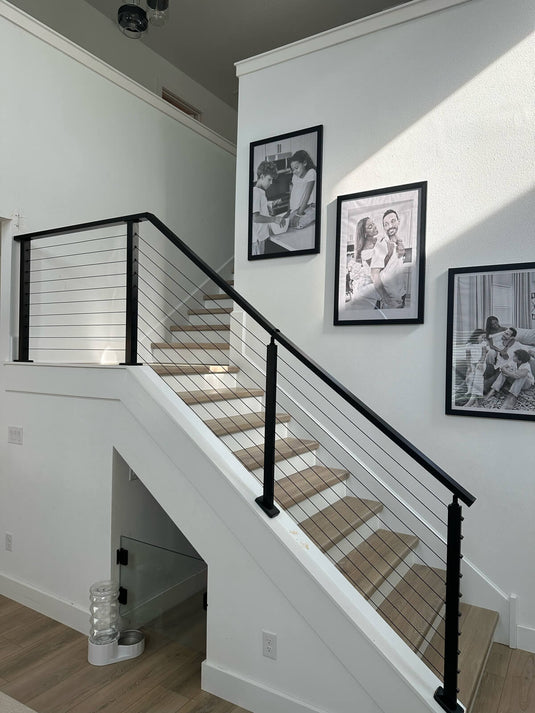TABLE OF CONTENTS
Tempered vs Laminated Glass: Which is Better?
In the vast expanse of modern construction and design, glass plays a pivotal role, serving not just as a barrier against the elements but also as a critical element in aesthetic and functional design. Among the various types of glass, tempered and laminated glasses stand out due to their unique properties and the safety features they offer. However, choosing between tempered and laminated glass requires understanding their distinctions, applications, and suitability for different environments.

Tempered Glass
Tempered glass, often referred to as toughened glass, undergoes a process of extreme heating followed by rapid cooling. This treatment drastically increases its strength compared to normal glass. The critical characteristic of tempered glass is its safety feature: when broken, it shatters into small, blunt pieces that are less likely to cause injury.
Laminated Glass
Laminated glass consists of two or more glass layers bonded together with an interlayer, typically made from polyvinyl butyral (PVB) or ethylene-vinyl acetate (EVA). This interlayer holds the glass sheets together even when broken, preventing the glass from shattering into sharp, dangerous pieces. Its ability to maintain structural integrity upon impact renders it particularly useful where safety is a paramount concern.
Differences Between Tempered and Laminated Glass
Safety
Both tempered and laminated glass are engineered to enhance safety, but they function optimally in different environments. Tempered glass is designed to crumble into granular chunks rather than jagged shards when broken. This characteristic minimizes the risk of injury in accidents, making it ideal for applications like side and rear windows in vehicles, glass doors, and sports facilities, where human impact is possible. Statistically, tempered glass is about four to five times stronger than standard glass of the same thickness.
Laminated glass, on the other hand, excels in preventing penetration. Its construction, typically involving a tough polyvinyl butyral (PVB) layer sandwiched between two sheets of glass, ensures that even if the glass cracks, shards remain adhered to the interlayer, maintaining the barrier. This feature is precious in areas where security is a concern, such as bank windows, storefronts, and locations prone to severe weather, effectively blocking break-ins or debris caused by storms.
UV-Resistance
UV protection is a crucial feature for glass installations where sun exposure is significant. Laminated glass offers up to 99% UV blockage due to its interlayer, which captures harmful ultraviolet light before it can enter a space. This protection helps in preserving the color and integrity of furnishings, artworks, and fabrics within a building. It is a preferred choice for museum displays, storefronts, and residential windows in sun-exposed locales.
Tempered glass does not inherently block UV rays but can be treated with coatings to enhance its UV-blocking capabilities. These coatings are an added expense but can be a worthwhile investment in office buildings and homes with extensive glass facades to reduce the heat gain and potential fading of interior materials.

Design Flexibility
In terms of design versatility, laminated glass takes the lead due to its ability to incorporate various colors, textures, and even digital prints between its layers. This flexibility makes it suitable for both exterior and interior design, fulfilling both aesthetic and functional roles. Architects and designers often use laminated glass in areas where visual impact is desired, such as in atriums and canopies, and as part of soundproofing solutions.
Tempered glass, while not as versatile in embedding varied designs, is praised for its clean, uninterrupted appearance. It is often used where clarity and durability are prioritized over pattern or color, such as in balconies, stair railings, and large-scale storefronts. Its seamless look supports a modern aesthetic, aligning well with minimalist design trends.
Cost
Cost considerations vary significantly between these two types of glass, primarily due to differences in manufacturing complexity. Laminated glass is typically more costly due to its layered structure and the materials used. The production process is also more resource-intensive, aligning with its premium positioning in the market.
Tempered glass, being less complex to manufacture, is generally more affordable and offers a good balance of safety and cost-efficiency for a wide range of applications. It is a cost-effective choice for many commercial and residential settings where large quantities of glass are needed without the specifications that necessitate laminated solutions.
Application
The application of each glass type is dictated by its physical properties and safety features. Tempered glass is often the go-to choice for situations where thermal resistance and durability are required, such as in patio doors, oven doors, and in places that experience significant temperature variations.
Laminated glass is preferred in settings that demand superior security and sound reduction. Its ability to effectively block noise makes it ideal for use in busy street-facing windows, high-end car windshields, and office partitions.
Installation and Maintenance
The installation of tempered glass is straightforward due to its single-layer structure, making it a quicker and often less costly process. It's also less prone to installation errors, which can occur with the alignment of laminated glass layers.
Laminated glass requires careful handling to ensure that the layers bond correctly without air pockets, which can compromise both aesthetics and functionality. Once installed, laminated glass may need more meticulous edge maintenance to prevent delamination or moisture ingress, which can fog the glass and weaken its structural integrity.
In maintenance terms, tempered glass is simpler to care for, being resistant to scratches and weather-related damage. Meanwhile, laminated glass, especially if exposed at the edges, can be sensitive to prolonged moisture exposure, requiring regular inspections and, potentially, more frequent replacements.
How to Choose

When selecting the appropriate type of glass for your project, consider these specific situations to guide your decision effectively:
Choose Tempered Glass if
- You prioritize injury prevention: Ideal for areas where safety is critical, such as in schools, gyms, or residential spaces where glass contact might occur frequently. Tempered glass shatters into dull-edged pieces, drastically reducing the risk of injury from sharp shards.
- Your project faces high temperatures: Useful in environments like kitchens, near fireplaces, or in exterior facades exposed to direct sunlight, where temperature changes are abrupt and significant. Tempered glass withstands these conditions without warping or breaking.
- Budget constraints are significant: If cost is a key factor, tempered glass offers a more affordable alternative to laminated glass, providing essential safety features and durability at a lower price point.
- Aesthetic simplicity is key: For projects that benefit from a minimalist design, such as modern homes or commercial spaces seeking a sleek, uninterrupted appearance, tempered glass offers a clear, unembellished aesthetic.
Choose Laminated Glass if
- Security and barrier maintenance are paramount: Essential for locations at high risk of break-ins or where maintaining an intact barrier even after impact is crucial—such as in jewelry stores, banks, or areas prone to severe weather conditions.
- Protection from UV rays is necessary: If the project involves protecting artworks, merchandise, or interiors from fading and sun damage, laminated glass blocks up to 99% of UV radiation, preserving the quality and color of exposed materials.
- Noise reduction is needed: Particularly beneficial in urban environments, near airports, or along busy streets where external noise can be a disturbance. The interlayer in laminated glass significantly reduces sound transmission, enhancing the comfort of indoor environments.
- Design customization is desired: If the project's aesthetic requires specific visual effects, such as tinting, patterns, or even embedding materials like fabric or digital prints, laminated glass provides these options without compromising the glass's integrity.
Both tempered and laminated glass offer distinct advantages, and the decision between them should be guided by an informed understanding of their properties and the demands of the intended application.




